What musical instruments did the Germans come up with? Five musical instruments invented in Germany
The search for an unusual and original sound sometimes forces musicians (sometimes just scientists who have a love for music and sound) to create completely new instruments. At the same time, not only are they taken as a basis modern technologies, but also the most incredible things: wheels, glass glasses, pipes, flasks with water, entire residential buildings and even caves.
Unusual musical instruments They sound (pardon the pun) unusual: some resemble the singing of whales and the play of the wind on a harp, others try to sound similar to more familiar violins, cellos or guitars.
We have collected (and continue to collect) the most unusual musical instruments from all over the world, figured out the history of their origin and found best examples sound.
Badgermin
Image of Badgermin (Badgermin) from NervousSquirrel.com.
In 2012, taxidermist and music lover David Cranmer came up with an incredible idea: place a theremin () inside a stuffed… badger!
The instrument was created in a single copy based on the PAiA Theremax Kit, consisting of a theremin control panel, two 8 mm antennas and the necessary cables for switching. The first performance using the badgerwox took place on January 1, 2012.
On a special website, Cranmer notes that he is ready to create a theremin of any kind to order. For example, a taxidermist later created a theremin owl using the same technology that was used to create a theremin from a stuffed badger.
We think Mr. Cranmer is a little crazy - his musical instruments are more strange than unusual.
Waterphone

Waterphones of different sizes.
The Waterphone was invented and patented by Richard Waters in 1968. As a musical instrument, the waterphone has been used in the soundtracks of films such as Let Me In, Poltergeist and The Matrix.
The main role in the instrument is given to water, thanks to which it sounds. The waterphone consists of a stainless steel resonator bowl and many bronze rods of varying lengths located along the edge of the bowl. Sounds are produced using a bow, rubber hammers, fingers and anything that can create vibrations. The movement of water inside the bowl changes the sound of the waterphone.
https://www.youtube.com/watch?v=foSJstDFDfg Video can’t be loaded: Waterphone Demo: Waters-Hubbert (https://www.youtube.com/watch?v=foSJstDFDfg)
The sound of the instrument has been compared to the singing of whales. According to Waters himself, one day Jim Knollman, a friend of the inventor, was playing a waterphone in the middle of the ocean. Waters claims that an impromptu concert near Hawaii attracted the attention of blue whales, which surrounded Knollman and did not swim away until the man finished his performance.
Hyperbass flute (Hyperbass flute)

First version of the hyperbass flute.
The hyperbass flute is the largest and lowest-sounding woodwind instrument, the length of which can reach 15 meters. The first example of a hyperbass flute was created by the Florentine master Francesco Romei for the Italian flautist Roberto Fabbriciani, who acted as a sponsor of the project. It was Fabbriciani who called the instrument a hyperbass flute (English: Hyperbass Flute, Italian: Flauto Iperbasso).
The instrument sounds four octaves lower than a regular concert flute (3 octaves below the bass flute, 2 octaves below the double bass flute and one octave below the double double bass flute). The bottom note is C0 (C subcontractave), which makes the hyperbass flute sound one octave lower than a regular piano. The lower sound of the instrument sounds at a frequency of 16 Hz, going beyond the capabilities of human hearing, which distinguishes sounds in the range from 20 to 20,000 Hz.
https://www.youtube.com/watch?v=ospGzeUncmI Video can’t be loaded: Mr Galway meet the hyperbass flute (https://www.youtube.com/watch?v=ospGzeUncmI)
The body materials are PVC and wood. The holes of the flute are covered with the entire hand, and the instrument does not have the usual keys.
Ceramic guitar

Ceramic guitar in the hands of Dan Erlwine.
It is unknown who created the ceramic guitar, but the American Dan Erlwine was the first to notice the unusual musical instrument.
In 1963, Erlwein got a job as an apprentice in the Herb David workshop. Guitar Studio in Ann Arbor, Michigan (USA), where he began to learn the basics of repairing and making guitars. By the mid-2000s, Erlwein had gone from journeyman to respected guitar luthier, with guitars passing through his hands numbering in the tens of thousands.
Erlwein admits that throughout his work he has seen many of the most bizarre guitars, but the most unusual instrument was a ceramic guitar that ended up in Dan’s hands in mid-2016. There is no information about who originally made this instrument, nor is there information about the technology for producing a ceramic guitar.
Hurdy-Gurdy

Street musician with a hurdy-gurdy.
The stringed reed instrument has been known in Europe since late XII century under the name "organist", and ancient images hurdy-gurdys dating from 1175 and 1188 have been discovered in English book miniature and on the bas-relief of the Cathedral of St. James in Spain. The oldest hurdy-gurdy, which has survived to this day, refers to XII century and is a bulky instrument for playing by two people - one rotates the handle, and the second changes the position of the rods.
With the advent of a lightweight hurdy-gurdy in the 13th century, the instrument became a mandatory attribute medieval culture minstrels. The lyre fell out of favor in the 15th century: by that time, the hurdy-gurdy was considered an instrument of tramps and beggars. The instrument's popularity returned in the 18th century, when the lyre gained popularity among the French aristocracy.
In Russia, hurdy-gurdy wheels appeared around the 17th century, also associated with tramps, beggars and buffoons performing simple and humorous songs to the accompaniment of the instrument. Despite difficult attitude From the people's side, in Russia the hurdy-gurdy acquired the status of a Russian folk instrument.
https://www.youtube.com/watch?v=QHmML7bu-iM Video can’t be loaded: Matthias Loibner hurdy gurdy master (https://www.youtube.com/watch?v=QHmML7bu-iM)
During playing, the lyre is placed on the lap, producing sounds by turning the handle of the wheel and changing the position of the rods to which the strings are connected. The number of strings reaches 11 pieces: most of of them vibrates monotonously and simultaneously as a result of friction on the wheel, and 1-4 separate strings reproduce the melody.
The sound of the hurdy-gurdy is distinguished by its power, monotony and minor nasal tone, evoking associations with the music of the peoples of the Middle East. Much of the sound quality depends on the precise centering of the wheel and the smoothness of its surface.
Cat Piano/Cat Harpsichord/Cat Organ

An image of a cat piano from the book “Magia Naturalis naturae et artis” (1657) by Gaspar Scott, a student of Athanasius Kircher.
Confirmed existence real prototype the cat piano does not exist, and the instrument itself is described only in XIX literature century in the form of a grotesque idea. However, we could not help but include it in the list of unusual musical instruments.
The description of the cat piano was first made by the German scientist Athanasius Kircher in the mid-1650s. According to Kircher, the instrument consists of a chain of 7-9 cats, fixed in one place, whose tails are connected to the keyboard. Cats and cats are selected according to the pitch of their meow. Pressing the keys pulled the animals by the tails, which began to scream in pain. Thus, the instrument described by the German is closer to the clavichord than the piano, which did not exist in Kircher's time.

A mention of such an instrument (regardless of Kircher’s descriptions) is found in the work “Musiciana, excerpts from an essay on rare or strange inventions” French writer Jean-Baptiste Weckerlen, written in 1887. Weckerlen talked about the piganino instrument (from the English Pig - pig), which used pigs as the sound source.
Chrysalis

Chrysalis.
A stringed musical instrument called the Chrysalis, designed by Chris Forster in 1975. Forster admits that the design of the instrument was influenced by Aztec stone calendars. The inventor describes the sound of the instrument as the wind playing on a harp.
The idea for the chrysalis came to Chris when he became interested in the possibility of using a wheel with strings as a musical instrument. Chrysalis consists of two wooden wheels, on which 82 strings are stretched. During the game, the wheels rotate freely in opposite directions.
Nikelharpa
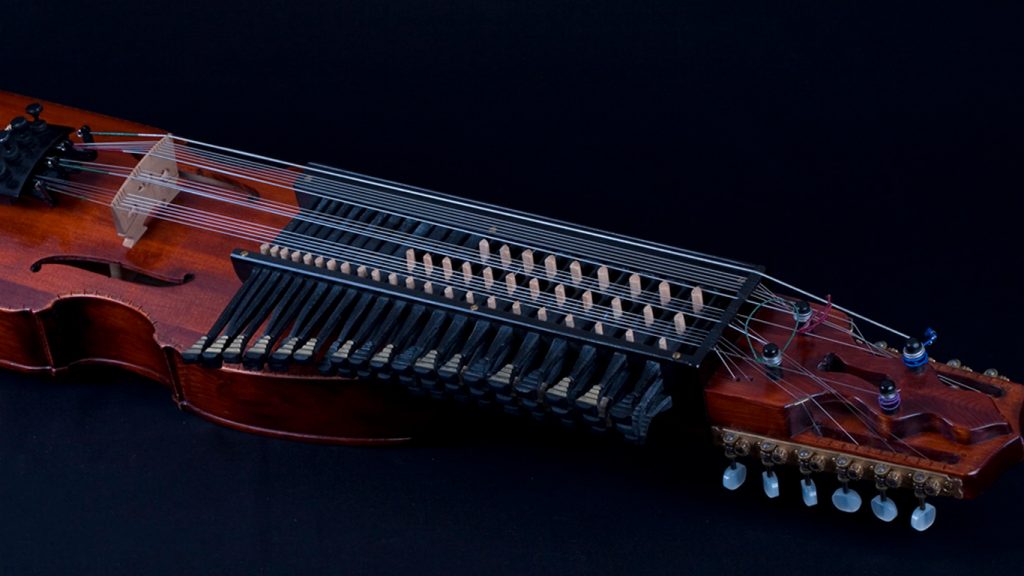
Modern nyckelharpa.
Nyckelharpa - traditional Swedish string instrument, whose history goes back more than 600 years. Previously, the instrument was also called nickelgiga, nickelspel and nickel-lyre. In Swedish, "nyckel" means a key, and the word "harpa" refers to any stringed instrument, be it a guitar, violin or double bass. Thus, the name of the instrument can be literally translated as “Keyboard Strings”.
The first evidence of the use of nyckelharpa is considered to be a bas-relief on the gate of Källunge Church on the Swedish island of Gotland, dated 1350. The bas-relief shows the silhouettes of two musicians playing the nyckelharpa. The oldest nyckelharpa that has survived to this day was found in the Swedish city of Mora in the province of Dalarna and dates back to 1526. This specimen is shaped like a lute, and has one row of keys and two strings.
In the first half of the 1900s, the instrument was considered “dead”, and in Sweden there were practically no musicians left who owned the nyckelharpa. However, in the 1960-1970s. nykelharpa regained popularity, which was not least facilitated by popular music, which was looking for new and unusual sounds.
The modern nyckelharpa is equipped with 16 strings (3 melodic, one monotone and 12 resonant strings) and 37 wooden keys designed to “slide” under the strings. The range of the instrument is 3 octaves, and the sound is reminiscent of a violin with increased resonance.
Today there are approximately 10,000 nyckelharpa players in Sweden, and among famous musicians Those who are fluent in this Swedish instrument include Ana Alkaide and Ritchie Blackmore.
Octobass
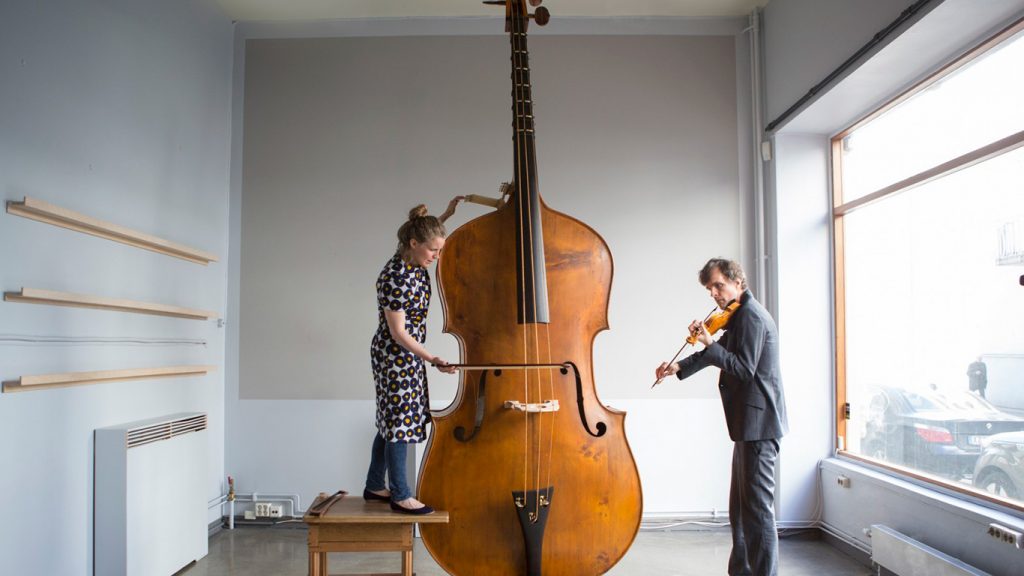
Guro Myo plays octobass at the Only Connect festival, Oslo, Sweden.
The largest in size and lowest in sound bowed instrument is considered an octobass, also called an octave double bass or subcontrabass.
The instrument is based on the judgment of some masters that the size of the double bass is too small to produce enough low sounds. The first copy of the octobass was created by the French violin maker Jean Baptiste Vuillaume in 1850.
The instrument amazed the imagination with its size and low sound, but did not gain much popularity - heavy and cumbersome, intended for playing by two (one octobassist holds the strings, the second uses a bow), the octobass was expensive and inconvenient, and the necessity of its presence in the orchestra raised many questions. However, some composers wrote scores specifically for the octobass: you can hear the sound of the instrument in the works of Richard Wagner, Pyotr Ilyich Tchaikovsky, and Johannes Brahms.
The history of the modern octobass begins with the American master John Geyer, who created a four-meter version of the instrument towards the end of the 20th century. Goyer equipped the octobass with three strings tuned to the notes C0 (C subcontractave, beyond the capabilities of human hearing), G0 (G subcontractave) and D1 (D counteroctave). As for the practical range of the instrument, it is small - from C0 (C subcontractive) to A1 (A counteroctave).
https://www.youtube.com/watch?v=0esCcp7pOj8 Video can’t be loaded: The “Jaws” theme on the octobasse (https://www.youtube.com/watch?v=0esCcp7pOj8)
Due to the enormous size of the octabass, you can play it either independently or together with another musician, standing on a special stool. The playing technique is similar to playing the double bass or violin.
Panopticon (Singing Ringing Tree)
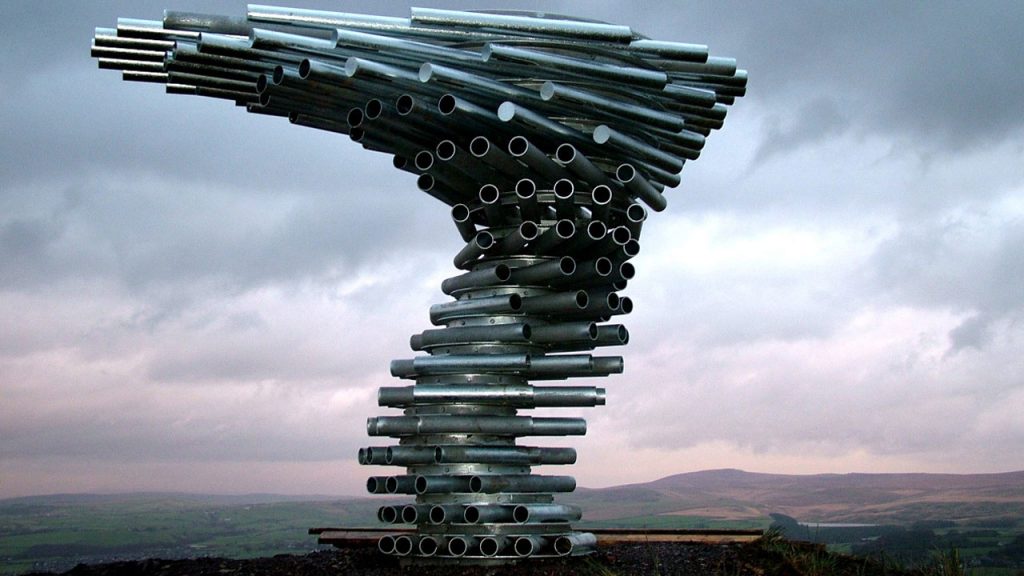
One of the four panopticons (The Singing Ringing Tree), installed in Lancashire.
Panopticon, also called Singing Ringing Tree ( verbatim from English "The Singing Ringing Tree"- a musical instrument and, at the same time, a sculpture in the form of a set of pipes laid out in the shape of a tree, producing sound due to the blowing of the wind. The sculpture is installed on the top of a hill near British city Burnley in Lancashire.
The Tree was erected in 2006 as part of the Panopticons series, consisting of four sculptures. The project was created by British designers Mike Tonkin and Anna Lew as part of the development of East Lancashire and increasing the tourist attractiveness of the region through the creation of a series of unusual artificial and natural art objects.
The panopticon is a three-meter-long structure consisting of several dozen galvanized steel pipes. The wind passing through the pipes results in a slightly discordant sound, reminiscent of choral singing. The sound range varies over several octaves.
Some pipes act as decorative elements and general composition, while the rest serve as a sound source. The harmonic and singing qualities of the “tree” depend on the strength of the wind, the presence of holes and recesses inside the pipes, as well as their length.
Pyrophone/Pyrophonic organ
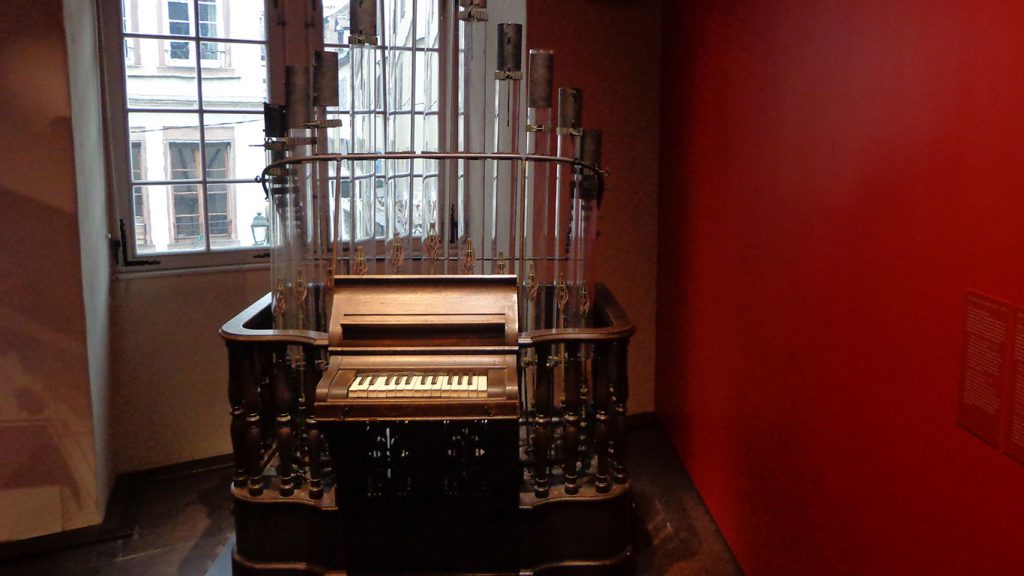
One of the pyrophones designed by Kastner, in Historical Museum Strasbourg.
The pyrophone (also called “pyrophonic organ”, “fire organ”, “explosive organ”) is a musical instrument invented and patented in the 19th century by the physicist and mathematician of French-German origin Georg Friedrich Eugen Kastner together with the French musicologist Albert Lavignac. Kastner has been interested in science since childhood, and one of the most famous works The scientist is considered to be the study of the “singing flame” that appears during the combustion of illuminating gas in glass tubes of a certain length.
In 1875 Kastner published the brochure "Singing Lights" (French: "Les flammes chantantes"), which aroused interest and attracted public attention to the invented instrument. One of the first musicians to master the pyrophone is Henri Dunant, the founder of the Red Cross and close friend Kastner's mother.
https://www.youtube.com/watch?v=Ao3jh3Rk6xY Video can’t be loaded: Michel Moglia. Les Chants Thermiques de l'Orgue à Feu. Performance à Dunkerque. (https://www.youtube.com/watch?v=Ao3jh3Rk6xY)
The first sample of a pyrophone consisted of a series of glass tubes different lengths connected to a keyboard, the keys of which controlled the flow of flame in each of the tubes. Kastner constantly worked to improve the pyrophone: gradually the instrument learned to more accurately control the flame. Propane was used as fuel for the pyrophone, although later mobile versions instruments connected to small barrels or tanks of gasoline, as well as pyrophone options using hydrogen.
However, mass production could not be established, and one of the first copies of the pyrophone exploded during the game and injured the musician. Currently, the pyrophone is not used, not produced, and practically not used in music.
Reactable

Reactable.
Reactable - multimedia music table, the surface of which simultaneously serves for input and output of information. The intuitive interface does not require specific knowledge from the user and allows you to literally touch the creation of music.
The basic operating principle of the instrument is borrowed from modular analog synthesizers from Moog, which use a system of special cells connected via cables to synthesize sound. In the case of reactable, software patches are used as the basis, and the role of honeycombs is played by special blocks made in the form of various geometric shapes.
https://youtu.be/Mgy1S8qymx0 Video can’t be loaded: ReacTj — ReacTable Trance live performance #2 (https://youtu.be/Mgy1S8qymx0)
Each block contains certain information. Upon contact with the working surface of the table, a signal is sent to the system processor, which is converted into an audio and visual message. The position and orientation of the block in space changes the sound parameters - so, different positions of one block affect the final volume, tonality and speed of sound extraction.
The Reactable was created by a group of European engineers from the University of Barcelona Pompeu Farba, and Sergi Jorda, Marcos Alonso, Martin Kaltenbrunner and Günther Geiger were responsible for the development of the prototype.
Symphonic House

Symphonic House. Outside view.
Symphonic House is a country cottage on the shores of Lake Michigan (USA). The unusual project of the instrument house was implemented by architect David Hanawalt and musician and musical instrument maker Bill Close. The work on the symphonic house required the creators to conduct research to find ideal harmonies in the vibrations, resonance and geometry of the premises.
According to Klose and Hanawalt, they were driven by the desire to find out if it was possible to increase the size of a musical instrument so much that a person could move freely inside it. “Being inside the instrument and playing it at the same time allows you to feel the sound with your whole body,” share the authors of the project.
There are strings stretched inside and outside the house, the length of which reaches six meters. For safety reasons, the tension force of the strings does not exceed 43 kilograms. To play, you need to wear cotton gloves soaked in a special powder to protect the strings from sweat and dirt particles that can cause corrosion and other destructive processes.
https://youtu.be/cjV31bw2bGQ Video can’t be loaded: David Hanawalt & William Close: The Symphonic House (https://youtu.be/cjV31bw2bGQ)
The sound of a symphonic house is deep and rich and somewhat reminiscent of a cello or viola with a richer top end. In addition to the physical impact on a person, the house begins to “sing” from gusts of wind, causing the strings to vibrate.
Stroch violin
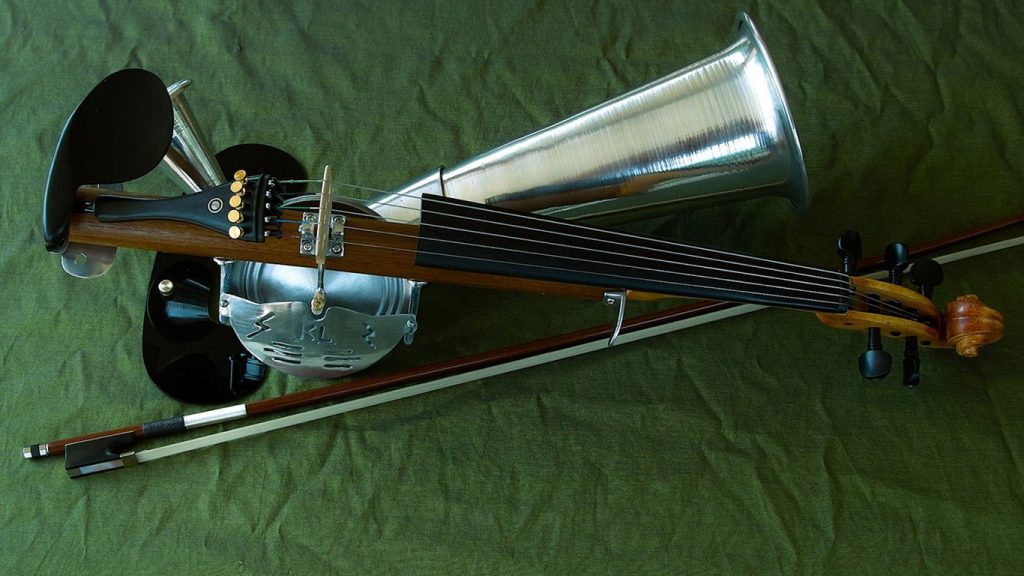
Stroch 5-string violin.
Before humanity learned how to make musical instruments sound using amplifiers and speakers, musicians were looking for ways to make the sound of their favorite instruments louder.
German inventor Johann Stroch late XIX century solved the problem most simple method, crossing a violin and a trumpet. The resulting instrument was called the “Stroch Violin” and looked like an ordinary violin with a bell attached. Thus, it is not the wooden body of the violin that acts as the resonator, but the aluminum bell.
The use of a bell made the sound of the violin louder and more focused, and the instrument was liked by theater and touring musicians - light and loud, Stroch’s violin allowed all the assembled listeners and spectators to enjoy the musicians’ performance.
https://www.youtube.com/watch?v=_ibIpex2tKY Video can’t be loaded: Violon violin trumpet Violon trompette.This is unbelievable! (https://www.youtube.com/watch?v=_ibIpex2tKY)
With the advent of microphones and electric violins, the instrument's popularity began to wane. However, at the beginning of the 20th century, on the territory of Moldova and Romania (regardless of Stroch’s invention) their own version of the violin with a resonator bell, borrowed from the gramophone, appeared.
Concerning modern musicians, then you can hear the sound of Stroch’s violin in some recordings by Tom Waits, Goran Bregovic and the Bat for Lashes group.
Stalactite organ
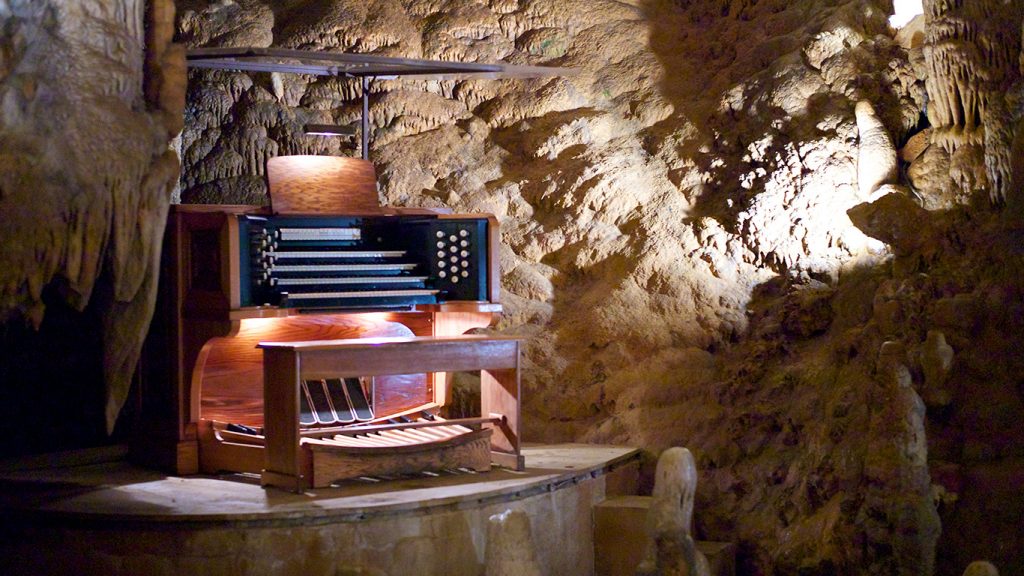
The Great Stalacpipe Organ.
A unique and unusual musical instrument located in Luray Caverns, Virginia, USA. In fact, it is a full-fledged organ created inside a cave from natural natural materials. The Guinness Book of World Records recognizes the stalactite organ as the “Largest Naturally Occurring Underground Instrument.”
The instrument was created by mathematician Leland Sprinkle in 1956. According to legend, Sprinkle's son hit his head on a low-hanging stalactite, and the sound of the impact impressed a scientist who assessed the acoustic characteristics of the cave.
It took Sprinkle several years of work to achieve the ideal sound of the instrument and the full functioning of the stalactite organ. The sounds produced by the instrument can be heard throughout the entire area of the cave, which is 14 km².
https://youtu.be/7ys5fdrsAUM Video can’t be loaded: The Stalacpipe Organ on “Ripley’s Believe It or Not” (https://youtu.be/7ys5fdrsAUM)
The organ's control console was designed by Klann Organ Supply and designed by Sprinkle. Wires are connected to the processed stones, through which special signals are transmitted to the attached hammers, which appear after pressing the keys of the instrument. The hammers strike the stones, producing sound.
In 2011, the Swedish-Finnish musical group Pepe Deluxe became the first group to record their own musical composition using a stalactite organ. Compositions using the organ were included on the album “Queen Of The Wave”, released in 2012.
Today, tours are held inside the cave, at the end of which anyone can purchase discs with recordings of music performed by organist Monty Maxwell.
Glass harmonica
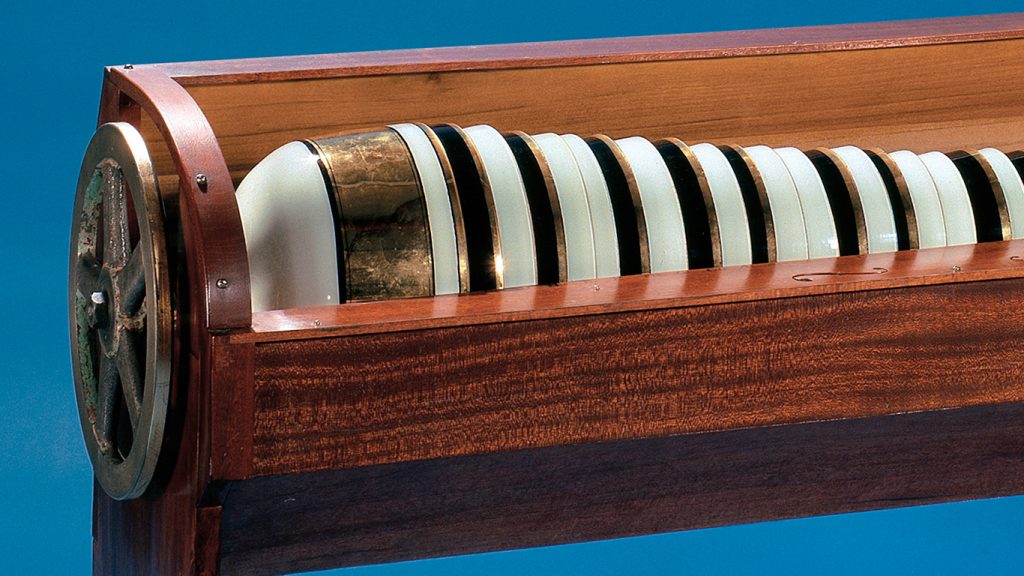
Glass harmonica with a modified design: instead of glasses, porcelain bowls are used inside.
The ancestors of the glass harmonica were the most ordinary glasses, the playing of which was known in Europe from mid-17th century century. Over the years, the ingenuity and skill level of musicians has grown tirelessly, and along with them the popularity of the instrument has grown.
Benjamin Franklin, who arrived in London in 1757, could not resist the unusual sound of glasses, which inspired him to create a glass harmonica. Replacing the dishes with glass hemispheres, Franklin placed the hemispheres on an iron axis, which rotated using a foot pedal.
The lower edges of the hemispheres were immersed in a resonator box filled with water, which made it possible to evenly moisten the glass containers. In turn, touching the musician’s fingers to the wet hemispheres led to the appearance of a gentle and pleasant sound.
During the XVIII-XIX centuries. The updated instrument was extremely popular. Thus, Wolfgang Amadeus Mozart, Ludwig van Beethoven, Mikhail Ivanovich Glinka, Richard Strauss and many other composers introduced glass harmonica into the scores of their own works. However, among composers there were also opponents of the harmonica, who believed that the sound of the instrument frightens animals and negatively affects state of mind people, leads to premature birth and mental disorder. Things got to the point where early XIX century, in some cities in Germany the use of glass harmonica was banned, which soon led to the “extinction” of the musical instrument.
In the 20th century, interest in the glass harmonica began to show again, and the instrument was able to leave the walls of museums and private collections. Over time appearance The instrument changed in every possible way, but Franklin's ideas remained fundamental.
Theremin
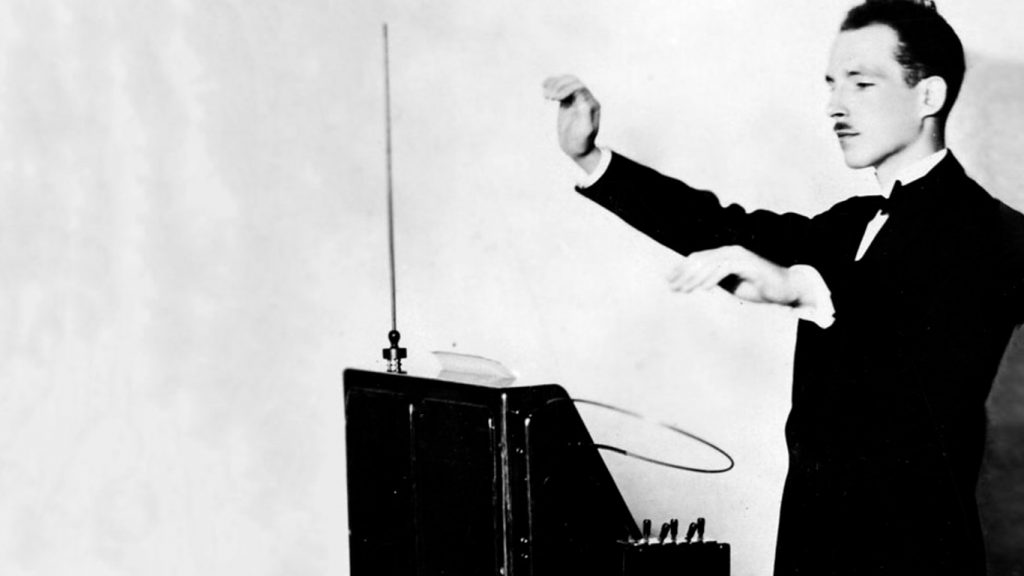
Playing the theremin.
The Theremin was created in Petrograd in 1919 by Russian inventor Lev Sergeevich Theremin. In fact, Theremin invented the first electronic musical instrument in the history of mankind, but the uniqueness of the theremin does not end there: sound production occurs not due to physical impact on the instrument, but due to the movement of the performer’s hands in an electromagnetic field near special antennas.
Theremin is intended for performance musical compositions any musical genres. At the same time, the instrument is popular not only among amateur experimenters, but also professional musicians. In addition to playing music, the theremin can create a variety of sound effects that are used in cinema, animation, theater and circus arts.
There are several varieties of theremin, differing in design features and functionality. In the classic theremin, changing the pitch of the sound is achieved by moving the hand closer to the right antenna, while the left antenna controls the volume of the sound. Later models, designed by other engineers, added controls to the instrument's design, allowing for much more manipulation of the sound. Despite its apparent simplicity, mastering the theremin requires considerable effort.
Fluba
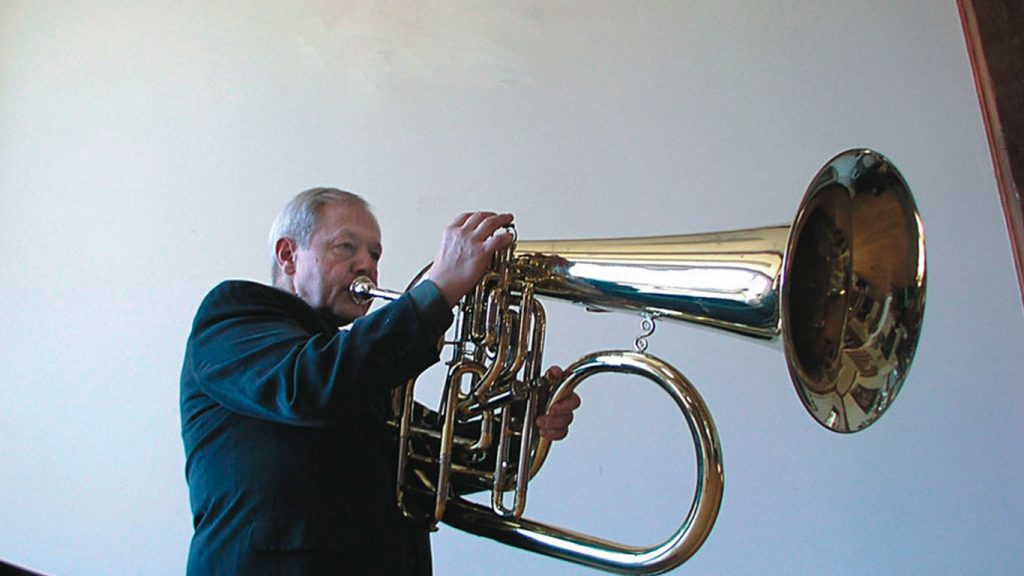
Jim Self plays flub.
The fluba owes its appearance to the legendary tuba player Jim Self and wind instrument maker Robb Stewart.
Fluba is a hybrid of a flugelhorn and a tuba, or a flugelhorn the size of a tuba. The principles of the game are identical to any wind instrument, and the sound resembles something between the donor instruments.
http://www.oddmusic.com/clips/fluba.mp3Yaybahar/Yaybahaj (Yaybahar)
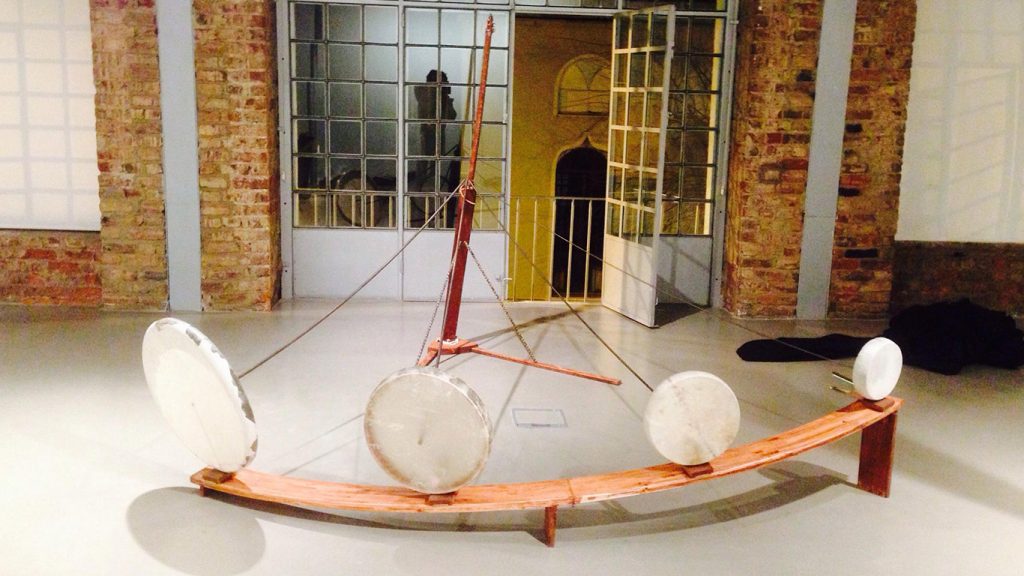
Yaybahar is in the house.
Yaybahar (the name in Turkish is “Yaybahaj”) was invented and designed by Turkish musician Görkem Şen in 2014, and combines simultaneously elements of percussion and bowed instruments.
It's hard to believe, but the yaybahar is a completely acoustic musical instrument. Vibrations of the strings are transmitted through coiled springs to a wooden membrane, and the sound, reflected from the membrane, is transmitted back to the springs, which leads to the emergence of new vibrations.
AlphaSphere

AlphaSphere (Alpha Sphere).
AlphaSphere features will appeal to amateurs electronic music, and the sound and appearance of the instrument make it possible to doubt the terrestrial origin of AlphaSphere.
The first developments of the innovative instrument were made by Adam Playson in 2007 while studying at the Faculty of Music and visual arts University of Bristol (UK). The unusual project did not go unnoticed by the administration educational institution— the young inventor was soon given a grant of £50,000 to implement the project.
The unusual musical instrument is based on 48 pads that are sensitive to the force and speed of pressing and a small computer running on the Max/MSP platform, whose software AlphaLive is compatible with any MIDI systems. AlphaSphere can connect to other computers or synthesizers to expand its own audio capabilities and load new samples. The user can customize the backlight of the device and program any zone with 8 different tones or melodies, which are switched by varying the force of pressing the pads.
Marble Machine
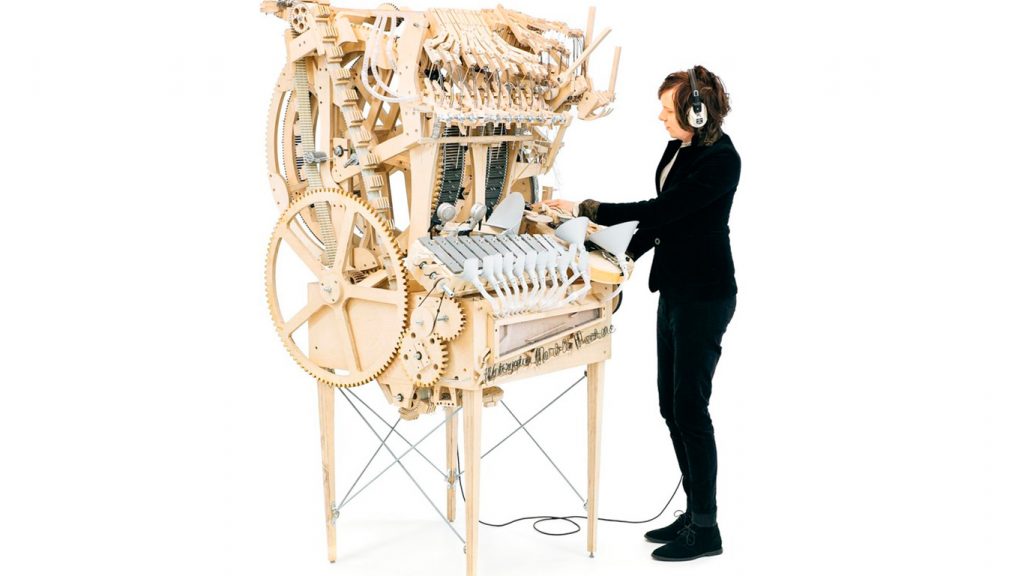
Marble Machine creator Martin Molin plays the instrument.
This unusual musical instrument was invented by Swedish musician Martin Molin. Molin says it took him about 14 months of continuous work to construct the Marble Machine.
https://www.youtube.com/watch?v=IvUU8joBb1Q Video can’t be loaded: Wintergatan — Marble Machine (music instrument using 2000 marbles) (https://www.youtube.com/watch?v=IvUU8joBb1Q)
The Marble Machine is a 3,000-piece mechanical wooden device that produces sound using 2,000 metal balls that continuously move through funnels, pulleys and pipes.
On January 14, 1690, the clarinet was invented in Germany.
In Nuremberg, the outstanding master Johann Christoph Denner improved the ancient pipe and created a wind reed musical instrument in the form of a thin wooden pipe. Here are five musical instruments invented in Germany.
Clarinet
Although the clarinet was invented in late XVII century, it has been actively used in music since the second half of the XVIII century. The tool is used in a wide variety of musical genres and compositions: as a solo instrument, in chamber ensembles, symphony and brass orchestras, folk music, on stage and in jazz. The clarinet has a wide range, warm, soft timbre and provides the performer with wide expressive capabilities. Concertos for clarinet were created such outstanding composers, like Mozart, Weber, Brahms.
Harmonica
Harmonica is a reed pneumatic musical instrument. Inside the harmonica there are metal plates (reeds) that vibrate in the air stream created by the musician. Unlike other reed musical instruments, harmonica does not have a keyboard, but instead uses the tongue and lips to select the hole (usually arranged linearly) corresponding to the desired note.
Harmonic in modern form invented by Christian Friedrich Ludwig Buschmann in 1821. The direct ancestor of the harmonica is the eastern organ, which came to Europe from China in mid-18th century century.
Although the harmonica originated in Germany, it became more popular in the United States. Most often it is used in such musical directions, like blues, folk, bluegrass, blues-rock, country, jazz, pop.
Harmonic
The accordion is the most famous reed keyboard-pneumatic musical instrument. There is no exact information about the origin of the accordion. Some consider it a Russian invention, but the main version says that the accordion was invented in Germany at the beginning of the 19th century by a native of the city of Friedrichrod, Christian Buschman.
The design of the accordion consists of a right and left half-body, on each of them there is a keyboard with buttons or keys. Left keyboard is intended for accompaniment, and the melody is played on the right. Between the half-cases there is a bellows chamber to allow air to be pumped to the sound bars of the instrument.
The accordion gained enormous popularity in Russia in the 20th century. At the end of the summer of 1941, about 12 thousand accordions were sent to the front to raise the morale of Russian soldiers, and in the fall of the same year - already more than 60 thousand.
Alto flute
The alto flute is a woodwind musical instrument, a type of transverse flute, designed by the German instrument maker Theobald Böhm around 1854. The structure and playing technique is similar to a regular flute, but has a longer and wider tube and a slightly different structure of the valve system. Breathing on the alto flute is used up faster.
The alto flute is used, as a rule, in an orchestra to produce specific low sounds of a special timbre, but in the second half of the 20th century it also began to be used as an ensemble and solo instrument. Rimsky-Korsakov was one of the first to prescribe its use in the opera-ballet Mlada (1890).
Tuba
Tuba is a wide-bore brass musical instrument, the lowest in register. In 1835, German musical instrument makers Wilhelm Wiepricht and Karl Moritz, through experiments with serpents and bass ophicleides, created a bass instrument and called it tuba. Due to unsuccessful scale relationships and design, the masters abandoned their invention. But the patent for the instrument was received on September 12, 1835. Later the instrument was improved in the second quarter of the XIX century inventor of musical instruments Adolphe Sax, who is also the creator of the saxophone. The tuba has a harsh, massive timbre in the lower register, dense and rich in the midrange, as well as a soft and melodious timbre in the upper register.
It is used mainly in symphony and brass orchestras, where it plays a role bass instrument in the brass group. The instrument is often used in jazz as well as chamber music.
Tags:
What could be surprising and unusual in your guitar, drums or synthesizer? Is it possible to somehow radically improve such familiar musical instruments? Our answer is – as much as possible!! =)
Today you can see these the most unusual musical instruments of the future. And it is precisely these musical instruments that will be discussed in our article today. By the way, I would like to remind you that we have already talked about unusual types of guitar picks.
Our modern world is unstoppably gaining momentum in the field of new technologies! They change our views, our thinking - they change us! Today, an “advanced” person must quickly “catch the wave” of iPads, TouchPads, Tablets, Androids and similar cyber innovations, otherwise he will be left “overboard.” And I had a question: how are new technologies introduced and synthesized with musical instruments that are so familiar to us? What will we play on in a couple of decades??? What it will look like guitar of the future?
What are we being prepared for and what should we prepare for, we read in order in my intelligence data :)
Various types of musical instruments of the future
Hyper Touch: Touch Guitar Without Strings
Our first exhibit in the series unusual musical instruments of the future is an original concept by audiophile designer Max Battaglia, who demonstrated a new approach to the traditional electric guitar. Instead of strings on the neck of this amazing musical instrument, a touch panel is used, which has various settings and modes (for example, 6-string and 12-string modes string guitar), which, according to the innovator, will provide new opportunities in sound extraction. Well, thanks to him for at least leaving the body shape of this guitar of the future familiar (and, by the way, a completely natural bridge lever), unlike the next instrument.

Kitar Guitar
And here again, no usual strings, just some kind of relative of the controller for Guitar Hero! But in fact, as Misa Digital claims, this is a full-fledged musical instrument - an unusual hybrid of a synthesizer and a guitar of the future. The Kitara Touchscreen features an 8-inch touchscreen display and buttons on the neck. By analogy with a synthesizer, hundreds of different sounds are recorded in the instrument’s memory. It went on sale at the end of 2011 and its cost ranges from $850 to $2,500. Well, it would be interesting to try; the design of this yet another unusual musical instrument is captivating. =)

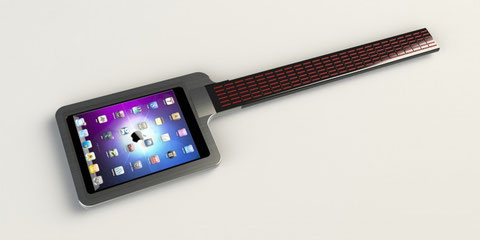
iTar – the guitar of the future
ITar - this future one is a development of Starr Labs, it is a synthesis of a push-button neck and the popular iPad tablet. This unusual guitar future(although it is very doubtful to apply the word “guitar” to this device) can easily perform the functions of other various musical instruments - drums, bass, or keyboards, for which special applications are launched. Everything is quite simple to use: the strings appear on the display, and the futuristic neck acts as a regular one. guitar neck. But, in my opinion, this is, of course, a toy, and not a musical instrument for a real musician.
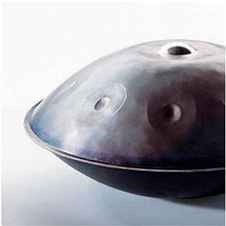
Today you won’t surprise anyone with electronic drum kits, Drum Pads and various controllers, but one very interesting development of the Swiss company “PANART” never ceases to amaze people, although it was created back in 2000.
Hang Drum is perfect unusual musical instrument, also known as a “hand drum”, looks like an alien flying saucer, you can extract sound from this miracle device different ways. For example, play with your fingertips, palm or its edge. This one consists unique musical percussion instrument of two connected metal hemispheres. The upper (sounding) hemisphere has 8 tonal zones that form a circle of sounds different tonality. This sound wave diverges from the upper dome from the lowest note to the highest.
The operating principle of this unique musical instrument was the result of many years of research into various metal and other percussion instruments. different countries world: gongs, bells, singing bowls, Indian drums Caribbean Sea, udu drums, etc. And most importantly, there are no rules for playing it, all you need are your hands and a love of music. =)
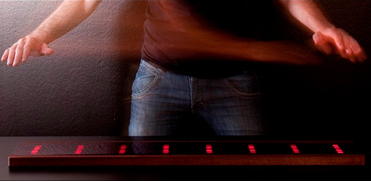
What does “ air piano" - this is true the most unusual musical instrument of the future. Playing it is so amazing that it seems like it was created by some other mind not from here... or by the famous engineer Omer Yosha.
The musical instrument is a long touch panel with a transparent glass cover. The sound range of the LED panel includes a full octave. To produce sound, the musician only needs to make several masterly movements in the air, without touching the instrument itself. A special interactive platform identifies the musician's movements and plays the corresponding notes. In general, this magic is a must see!
Thanks to musical instruments, we can produce music - one of the most unique creations of man. From trumpet to piano and bass guitar, they have been used to create countless complex symphonies, rock ballads and popular songs.
However, this list contains some of the strangest and most bizarre musical instruments that exist on the planet. And, by the way, some of them are from the category of “does this even exist?”
So here are 25 truly strange musical instruments - in sound, design or, most often, both.
25. Vegetable Orchestra
Created almost 20 years ago by a group of friends who were passionate about instrumental music The Vegetable Orchestra in Vienna has become one of the strangest musical instrument groups on the planet.
The musicians make their instruments before each performance - entirely from vegetables such as carrots, eggplants, leeks - to create a completely unusual performance that the audience can only see and hear.
24. Music Box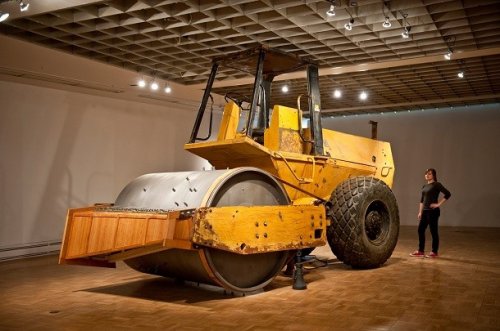
Construction equipment is most often noisy and annoying with its rumble, in strong contrast to a small music box. But one massive music box has been created that combines both.
This nearly one-ton vibratory compactor has been redesigned to spin just like a classic music box. He can play one famous tune - “The Star-Spangled Banner” (US anthem).
23. Cat piano
I would like to hope that the cat piano never becomes a real invention. Published in a book highlighting strange and bizarre musical instruments, the "Katzenklavier" (also known as the cat piano or cat organ) is a musical instrument in which cats are seated in an octave according to the tone of their voice.
Their tails are extended towards the keyboard with nails. When the key is pressed, the nail presses painfully on the tail of one of the cats, which produces the desired sound.
22. 12-neck guitar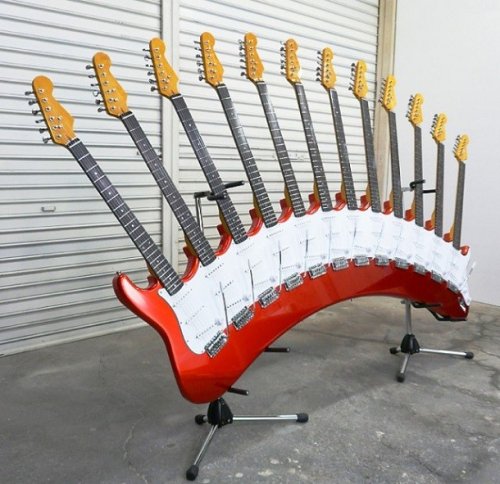
It was pretty cool when Jimmy Page from Led Zeppelin played on stage on a double-neck guitar. I wonder what it would be like if he played that 12-neck guitar?
21. Zeusaphone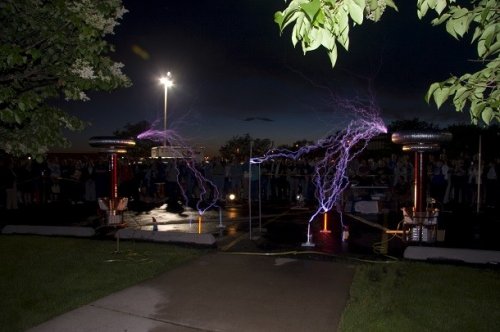
Imagine creating music from electrical arcs. Zeusophone does just that. Known as the "Singing Tesla Coil", this unusual musical instrument produces sound by altering visible flashes of electricity, thereby creating a futuristic sounding instrument electronic properties.
20. Yaybahar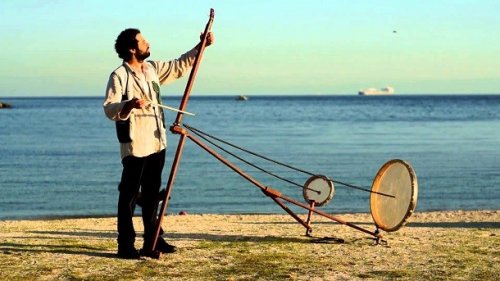
Yaybahar is one of the strangest musical instruments that came from the Middle East. This acoustic instrument has strings connected to coiled springs that are stuck into the center of the drum frames. When the strings are played, the vibrations echo throughout the room, like echoing in a cave or inside a metal sphere, creating a hypnotic sound.
19. Sea organ
There are two large sea organs in the world - one in Zadar (Croatia) and the other in San Francisco (USA). They both work in a similar way - with a series of pipes absorbing and amplifying the sound of the waves, making the sea and its vagaries the main performer. The sounds that the sea organ makes have been compared to the sound of water entering the ears and the didgeridoo.
18. Pupa (Chrysalis)
The doll is one of the most beautiful instruments in this list of weird musical instruments. The wheel of this instrument, modeled after the massive, round, stone Aztec calendar, rotates in a circle with with stretched strings, producing a sound similar to a perfectly tuned zither.
17. Janko Keyboard
Janko's keyboard looks like a long, irregular chessboard. Developed by Paul von Jankó, this alternative arrangement of piano keys allows pianists to play such musical works, which cannot be played on a standard keyboard.
Although the keyboard looks quite difficult to play, it produces the same number of sounds as a standard keyboard and is easier to learn to play because changing the key only requires the player to move their hands up or down, without having to change fingerings.
16. Symphony House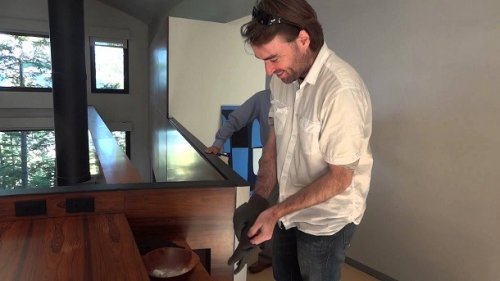
Most musical instruments are portable, and the Symphony House is definitely not one of them! IN in this case the musical instrument is an entire house in Michigan with an area of 575 square meters.
From the opposite windows that allow the sounds of nearby coastal waves or the noise of the forest to penetrate, to the wind blowing through the long strings of a distinctive harp, the entire house resonates with sound.
The largest musical instrument in the house is two 12-meter horizontal beams made of anegri wood with strings stretched along them. When the strings are played, the entire room vibrates, giving the person the feeling of being inside a giant guitar or cello.
15. Theremin
Theremin - one of the very first electronic instruments, patented in 1928. Two metal antennas determine the position of the performer's hands, changing the frequency and volume, which are converted from electrical signals into sounds.
14. Uncello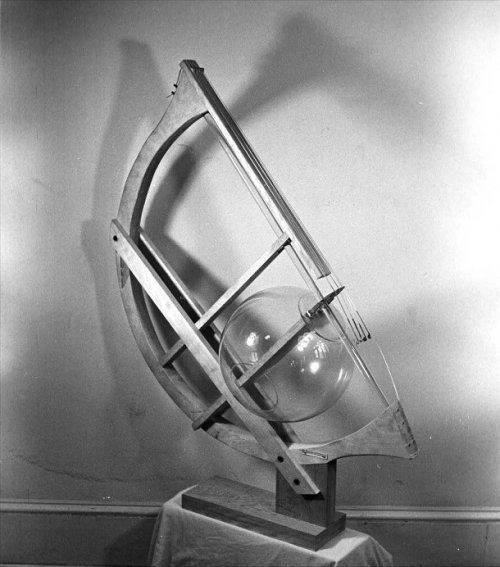
More like the model of the universe proposed by Nicolaus Copernicus in the 16th century, the unzello is a combination of wood, pegs, strings and an amazing custom resonator. Instead of a traditional cello body that amplifies the sound, the unzello uses a round fishbowl to produce sounds as the bow is played across the strings.
13. Hydrolophone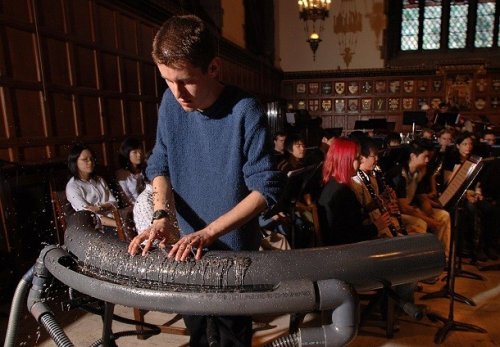
Hydrolophone is a musical instrument new era, created by Steve Mann, which emphasizes the importance of water and serves as a sensory exploration device for the visually impaired.
Essentially, it is a massive water organ that is played by plugging small holes with your fingers, from which water slowly flows, hydraulically creating the traditional organ sound.
12. Bikelophone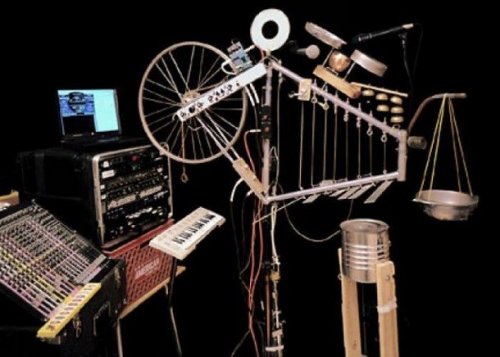
The Baiklophone was built in 1995 as part of a project to explore new sounds. Using a bicycle frame as a base, this musical instrument creates layered sounds using a loop recording system.
It is constructed with bass strings, wood, metal telephone bells and more. The sound it produces is truly incomparable because it produces a wide range of sounds from harmonious melodies to sci-fi intros.
11. Earth Harp
Somewhat similar to the Symphony House, the Earth Harp is the longest in the world string instrument. A harp with stretched strings 300 meters long produces sounds similar to a cello. A musician wearing cotton gloves coated with violin rosin plucks the strings with his hands, creating an audible wave of compression.
10. Great Stalacpipe Organ
Nature is full of sounds that are pleasant to our ears. Combining human ingenuity and design with natural acoustics, Leland W. Sprinkle installed a custom lithophone in Luray Caverns, Virginia, USA.
The organ produces sounds of varying tones using tens of thousands of years old stalactites that have been converted into resonators.
9. Serpent
This bassy wind instrument, with a brass mouthpiece and finger holes like a woodwind, was so named because of its unusual design. The curving shape of the Snake allows it to produce a unique sound, reminiscent of a cross between a tuba and a trumpet.
8. Ice Organ
The Swedish Ice Hotel, built entirely of ice in winter, is one of the most famous boutique hotels in the world. In 2004, American ice sculptor Tim Linhart accepted an offer to build a musical instrument that would fit the hotel's theme.
As a result, Linart created the world's first ice organ - an instrument with pipes entirely carved from ice. Unfortunately, the life of this unusual musical instrument was short-lived - it melted last winter.
7. Aeolus
Looking like an instrument modeled after Tina Turner's bad hairstyle, the aeolus is a huge arch with many pipes that catches every breath of wind and converts it into sound, often produced in the rather eerie tones associated with a UFO landing.
6. Nellophone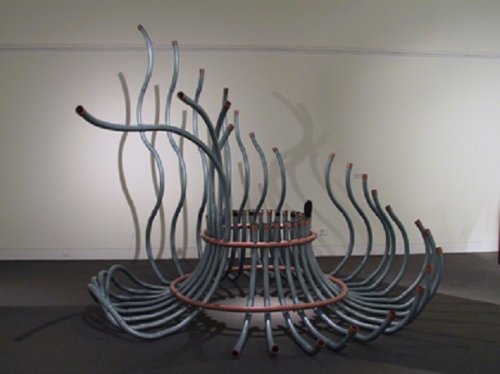
If the previous unusual musical instrument resembles Tina Turner's hair, then this one can be compared to the tentacles of a jellyfish. To play a nellophone, which is constructed entirely of curved pipes, the performer stands in the center and strikes the pipes with special paddles, thereby producing the sound of the air resonating within them.
5. Sharpsichord
One of the most complex and strange musical instruments on this list, the sharpsichord has 11,520 holes with pegs inserted into them and resembles a music box.
When the solar-powered cylinder turns, a lever rises to pluck the strings. The power is then transferred to the jumper, which amplifies the sound using a large horn.
4. Pyrophone Organ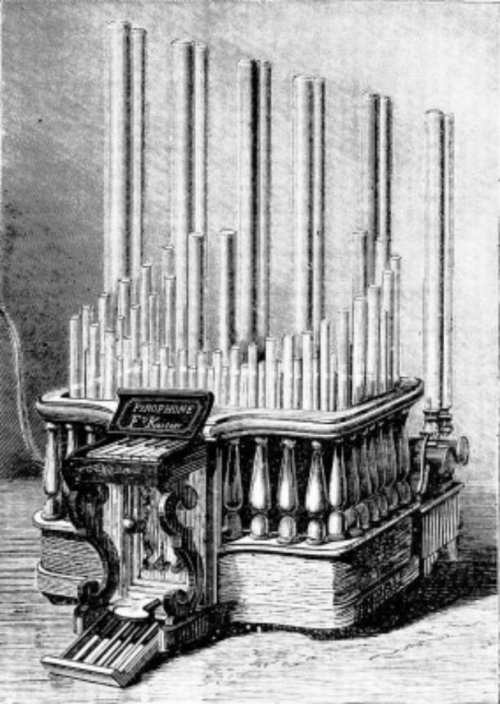
This list covers a lot various types remade organs, and this one may be the best of them all. Unlike using stalactites or ice, the pyrophonic organ produces sounds by creating mini-explosions with each keystroke.
Hitting the key of a propane and gasoline-powered pyrophonic organ provokes exhaust from the pipe, like a car engine, thereby creating sound.
3. Fence. Any fence.
Few people in the world can claim to be a “fence-playing musician.” In fact, only one person can do this - Australian Jon Rose (already sounds like the name of a rock star), creating music on fences.
Rose uses a violin bow to create resonating sounds on tightly strung - from barbed wire to the mesh - "acoustic" fences. Some of his most provocative performances include playing on the border fence between Mexico and the United States, and between Syria and Israel.
2. Cheese Drums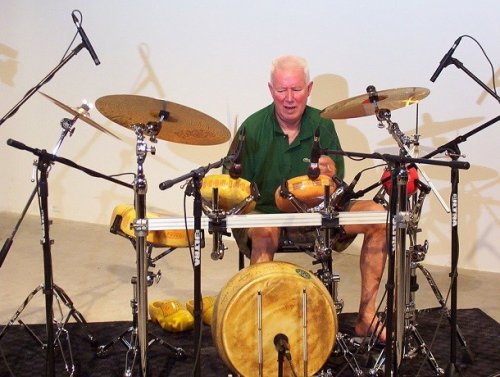
Being a combination of two human passions - music and cheese - these cheese drums are truly wonderful and very strange group tools.
Their creators took the traditional drum kit and replaced all the drums with massive round wheels of cheese, installing a microphone next to each to produce more delicate sounds.
For most of us, their sound will be more like the drumsticks of an amateur drummer sitting in a local Vietnamese restaurant.
1. Loophonium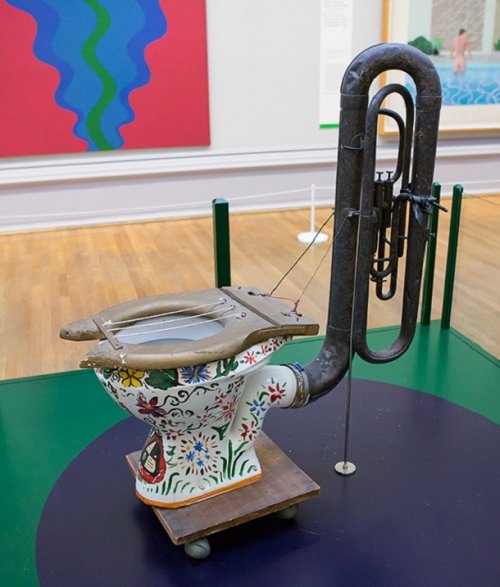
As a small tuba-like bass musical instrument that plays a leading role in brass and military bands, the euphonium is not such a strange instrument.
That is, until Fritz Spiegl of the Royal Liverpool Philharmonic Orchestra created the toiletphonium: a fully functioning combination of a euphonium and a beautifully painted toilet.
Theremin
Many have heard this musical instrument without knowing it, for example, in old horror films.
The Theremin was invented by Russian scientist Lev Theremin in 1928. It produces a rather unusual, even slightly creepy, vibrating sound that many underground musicians adore. However, it was the sound of the instrument that prevented it from gaining widespread popularity. Playing the theremin involves the musician changing the distance from his hands to the antennas of the instrument, due to which the pitch of the sound changes.
Banjolele
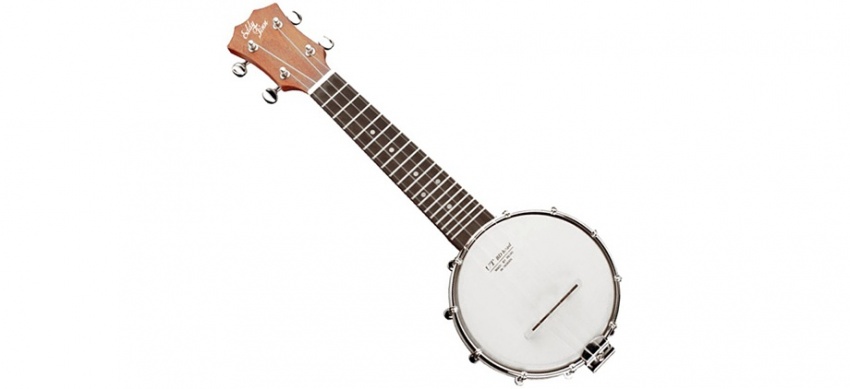
Despite the fact that both the banjo and the ukulele quickly gained an army of numerous fans, the hybrid of these two instruments, the banjolele, never became popular. It's essentially a very small banjo, only with four strings instead of five. The instrument produces a pleasant, soothing sound, but it is difficult for people with disabilities to play it. big hands quite problematic. Maybe that’s why, or maybe because of the cacophony of its name, the banjolele has remained a niche instrument.
Omnicord

Omnicord is an electronic musical instrument introduced by Suzuki in 1981. Sounds in it are created by pressing the button corresponding to the chord and striking a special metal plate. Being incredibly easy to use, the omnicord had every chance of becoming popular, especially among new musicians. But he never did. Famous melody from Clint Eastwood song British group Gorillaz is perhaps the most famous work played on this musical instrument.
Baritone guitar

Both the bass guitar and the regular guitar are among the most popular instruments in the world. However, as in the case of banjolele, their hybrid, despite its deep and rich sound, was not particularly widespread. Due to their design, such guitars sound much lower than ordinary ones. Nowadays they are sometimes used in recording studios to give the main guitar part a richer tone.
Glucophone
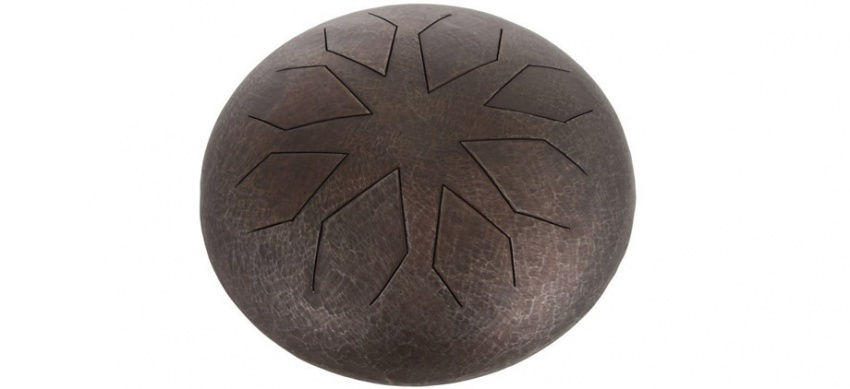
Despite the cacophony of its name, this instrument produces very pleasant sounds. Most of all it looks like a metal hand drum. It consists of two bowls, on one of which there are “tongues” of the drum, and on the other there is a resonating hole. Each bowl can be fine-tuned.
The instrument has found some popularity among street musicians, however, it still cannot be called mass.
Keytar
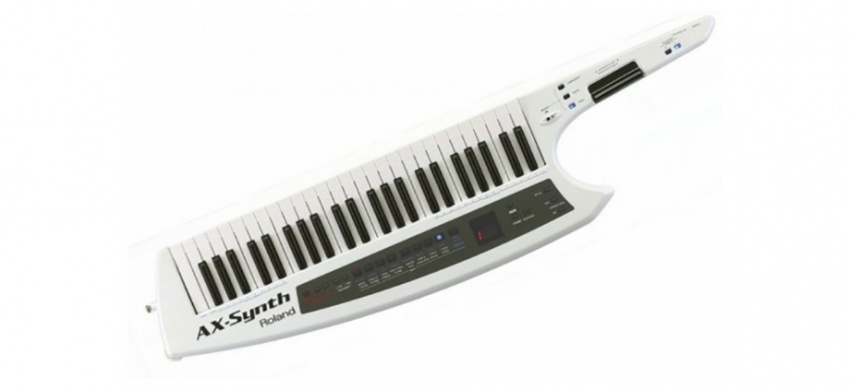
In the 80s, on the wave of popularity of pop music, this instrument almost entered the mainstream. Almost…
In essence, this is an ordinary synthesizer enclosed in a plastic guitar case. As with previous hybrids, it is mainly played only as needed. One of its main advantages is its compactness.
Few people know that Matthew Bellamy, leader of the popular British band Muse, regularly uses the keyboard at his performances.
Wind synthesizer "Evi"
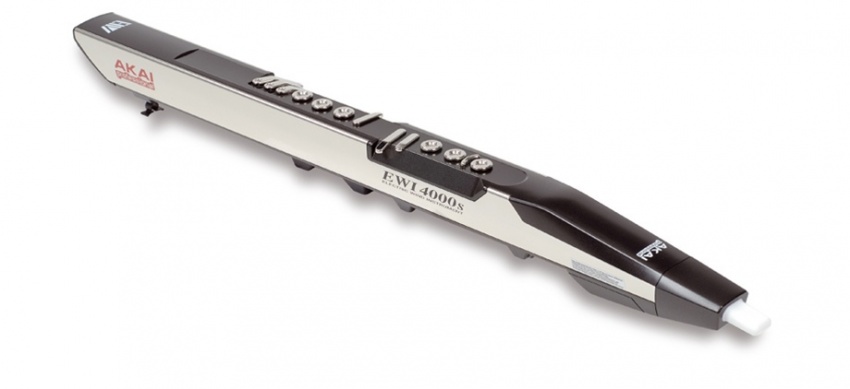
"Evi" is the most popular wind synthesizer, but is still unknown to a huge number of music fans. It is a mixture of saxophone and synthesizer. The principle of playing it is almost the same as the saxophone. However, the “synthesizer past” of the instrument makes it possible to connect it to a computer.
Electronium
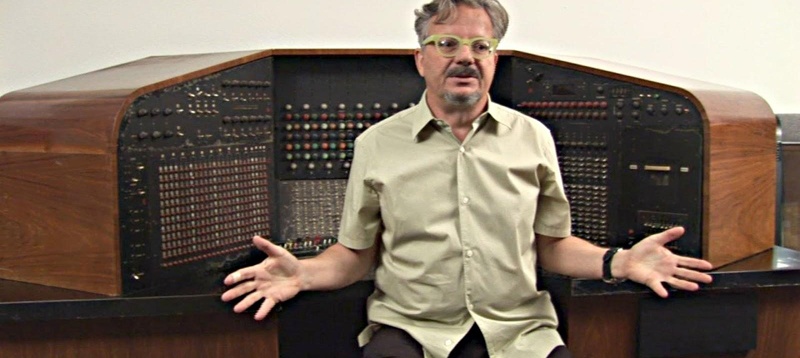
The most mysterious instrument in our selection. It was invented by inventor Raymond Scott. Little is known about it, other than that it is a huge prototype of a modern synthesizer. The only remaining Electronium belongs to composer Mark Mothersbaugh, and even that doesn't work.
Musical saw
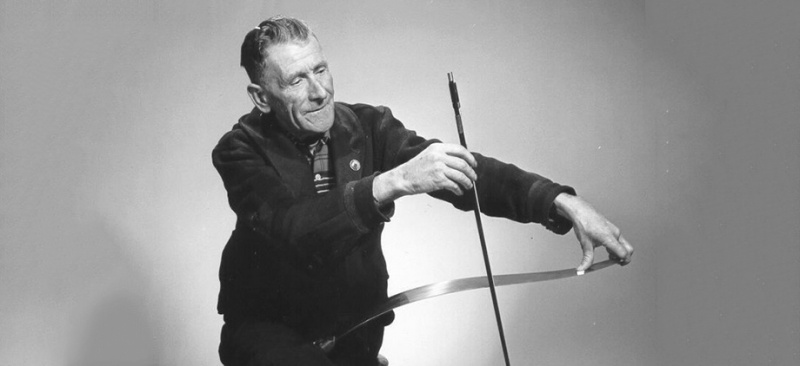
This saw differs from a regular saw only in that it can bend much more strongly. When playing, the musician rests one end of it on his thigh and holds the other end with his hand. The sound is produced with a special bow. It must be said that the unusual sound of the saw can be heard in the compositions of some folk groups. However, outside the genre ethnic music it was not widely used.
"Waves of Martino"
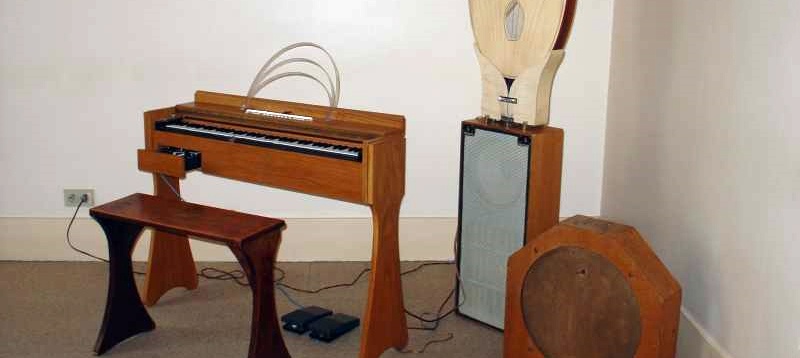
Perhaps the most unusual instrument in the selection. It was invented by Maurice Martineau in 1928. The sound of the instrument is simultaneously reminiscent of a violin and a theremin. The design of the French invention is quite complex: when playing, the musician needs to simultaneously press the keys and pull a special ring. By the way, Radiohead member Jonny Greenwood used “Waves of Morteno” when recording several songs, giving them a unique sound







